19.12.2005
Round 1: Khalifman-Volkov
Annotated live by Konstantin Sakaev
Khalifman,A (2653) - Volkov,S (2614) [D15]
ch-RUS Superfinal Moscow, 2005
1.d4 d5 2.c4 c6 3.Nf3 Nf6 4.Nc3 a6
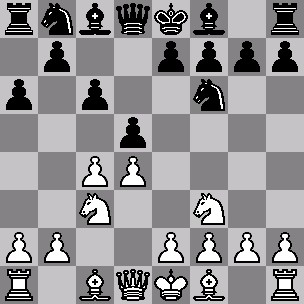
5.g3!? This rare move is not without some venom, I used it myself a few times. The fact that Alexander Khalifman addresses to it is indirect confirmation of Black's strength in the main lines of a7-a6 (Chebanenko) variation. It is difficult for White to obtain an advantage.
5...b5 I like playing the structure that arises after this typical pawn advance as White. Safer for Black is 5...dxc4. Now 6.a4 e6 7.Ne5 c5 leads to an even ending, and in case of 6.Bg2 b5 we get into the Catalan opening with White's knight prematurely arriving to с3. It seems Alexander was ready to give such "handicap" to his opponent, but Sergey nevertheless wanted to play his pet opening. We'll see what happens...
This pawn structure is very peculiar: Black does not have to worry about White's pawn advances on the queenside, but White's healthy "tooth" on c5 will remain there for the whole game - Black's had deprived himself of an undermining b7-b6.
6.c5 g6 If you want someone's opinion about 6...e6, ask the c8-bishop.
7.Bg2 Bg7 8.0-0 0-0 9.h3?!
I don't like this strategically useful move, because White might be lacking time to strengthen his positions in the center. Once I managed to win a game in which Black's main disadvantage - the lack of space - eventually told. Here it is: 9.Ne5! Be6 10.h3 Qc8 11.Kh2 Nfd7 12.Nf3 Nf6 13.Ne5 Nfd7 14.f4 f5 15.Be3 a5 16.g4 Nf6 17.gxf5 Bxf5 18.Bf2 Qe6 19.Bh4 Nbd7 20.e3 h6 21.Bxf6 Nxf6 22.Ne2 Ne4 23.Bxe4 Bxe4 24.Ng3 Bf5 25.Nxf5 Rxf5 26.Qg4 Bxe5 27.dxe5 Kh7 28.Rg1 Qf7 29.Rg2 a4 30.Rag1 Rg8 31.Qd1 Rg7 32.Rg3 Qe6 33.R1g2 Rf8 34.Qg4 Qf5 35.Qxf5 Rxf5 36.Rg4 Rff7 37.h4 e6 38.Kg3 h5 39.Rg5 b4 40.Kf3 Rb7 41.Rg1 Rb5 42.Rc1 Ra7 43.Ke2 Rg7 44.Kd3 Kg8 45.Kd4 Kf7 46.e4 dxe4 47.Kxe4 Rg8 48.Rg3 Rd8 49.Rd3 Rd5 50.Rxd5 exd5+ 51.Kd4 Rb8 52.Rg1 b3 53.a3 Rf8 54.Ke3 Kg7 55.Rd1 Ra8 56.Kd4 Rf8 57.Rf1 Rf7 58.Kc3 Rb7 59.f5 gxf5 60.Rxf5 Re7 61.Kb4 Ra7 62.Rf6 Ra6 63.Kc3 Kh7 64.Rd6 Kg7 65.Kd4 1-0 Sakaev,K-Najer,E/Istanbul 2003
9...Nbd7 10.Be3 b4
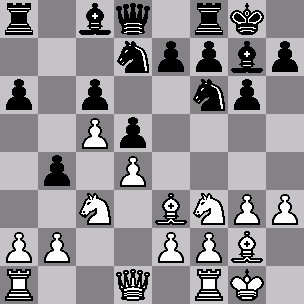
Interesting, but very demanding move: Black will inevitably lose the b4-pawn, but he brings the knight back to the starting position, his light-squared bishop comes out to a6, and, finally, it becomes easier to carry out a freeing break e7-e5.
11.Nb1! The knight is useless on a4, and it also blocks his own rook.
11...a5 12.a3 Ba6 13.axb4 axb4 14.Ra4 Bb5 Black can not hold the pawn: 14...Qb8? 15.Bd2; a complex position arises after 14...Ne4!? 15.Rxb4 Qa5 16.Rb3 e5 17.Nc3.
15.Rxb4 Qa5 Interesting is 15...Ra1!? , and now 16.Rxb5!? cxb5 17.Qb3 deserves attention: White has more than sufficient compensation for the exchange, as Black will have to part with the b5-pawn.
16.Bd2 Ne4 17.Re1 White defends against e7-e5 in advance, preparing to meet it by e2-e3.
17...Nxd2 18.Qxd2 e5 Black must open up the position, or it will be too late: 18...Nf6 19.Ne5 (19.Rb3 is also possible) 19...Ne4 20.Bxe4 dxe4 21.Na3 The position is rather locked, so Black's bishop pair can not make a real impact.
19.Na3 19.Nxe5 plays into Black's hands: 19...Nxe5 20.dxe5 Bxe5 21.e4 dxe4 22.Rexe4 Rad8 , and activity of Black's pieces compensates his minus pawn.
19...Ba6 One could force the knight to h2 by 19...e4, but it did not bring real benefits.
20.Nc2 Qc7
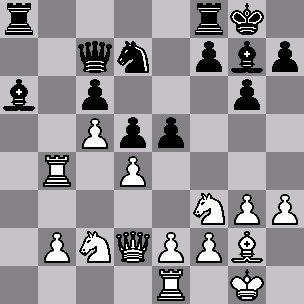
21.Rc1? A loss of time. If White wanted to keep the pawn on d4, it was better to play 21.Ra4 , and if 21...exd4 , then 22.b4. However, the strongest move here was 21.Nxe5! Nxe5 22.dxe5 Qxe5 23.Nd4, and Black's compensation for a pawn is clearly inadequate.
21...e4 22.Nh2 e1 is also an ugly square for the knight, but at least it is closer to the queenside. I prefer 22.Nfe1 f5 23.Ra1.
22...f5 23.Ra4 Now, I think, 23.Ra1 was more precise.
23...Bb5 24.Rxa8 Rxa8 25.Bf1 I dislike the very idea of exchanging the bishops, as White's king becomes too weak. Better is 25.Ra1 Rb8 26.Na3 Ba6 27.b4, preparing b4-b5, even if it is connected with returning an extra pawn in some lines.

25...Nf8! A very good although typical knight transfer to e6.
26.e3 Bxf1 27.Nxf1 Ne6 The position has defined. Black has a good compensation for a pawn.
28.h4 h6 29.Ra1 Rb8
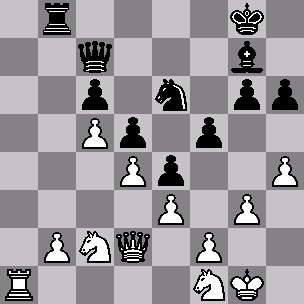
30.Ne1? I do not understand such a passive move. Natural and good was 30.b4 g5 31.hxg5 hxg5 32.Ra6.
30...g5 31.Ng2 Bf6 32.hxg5 hxg5 33.Ra6 f4 34.gxf4 It looks very risky. It is still more logical to play on a wing where you are stronger: 34.b4.
34...gxf4 35.Nxf4 Nxf4 36.exf4 Qg7+ 37.Kh1 Bxd4 38.b4 38.Rxc6 leads to mutual annihilation: 38...Rxb2 39.Qd1 Rxf2 40.Rc8+ Kh7 41.Qh5+ Qh6 42.Rc7+ Bg7 43.Ng3 Rxf4 44.Qxh6+ Kxh6 45.Rxg7 Rh4+ 46.Kg2 Kxg7 47.Nf5+ Kf6 48.Nxh4 Ke6, with a draw.
38...Qb7. An unexpected move repetition could occur after 38...Bc3 39.Qe3 (39.Qe2 Qg6 40.Rb6 Rf8 41.Nh2 Rxf4 42.b5 Rh4 43.Rxc6 Qf5, and Black has a dangerous initiative) 39...Bd4 40.Qd2.
39.Qe2 Bxf2. 39...Kf8 is not dangerous for White: 40.Kg2 Qc8 41.Rb6 Rxb6 42.cxb6 Bxb6 43.Ng3, and the position is close to a draw - Black's pawn structure is better, but the knight is stronger than the bishop, and White's king is safer.
40.Kg2 Bd4 41.Ng3 Qc8 42.Qh5 All variations lead to a draw, for instance, 42.Nxe4 A) 42...Rxb4 43.Nd6 Qd7 (43...Rb2 44.Nxc8 Rxe2+ 45.Kf3=) 44.Ra8+ Kg7 45.Qh5 Rb2+ 46.Kg3 Rb3+ 47.Kg2 Rb2+=; B) 42...dxe4 43.Qc4+ Kh7 44.Qxd4 Qg4+ 45.Kf2=;
42.Ra7 Rxb4 43.Qh5 Rb7 44.Rxb7 Qxb7 45.Qe8+ Kh7 46.Nxe4 Qb2+ 47.Kh3 dxe4 48.Qxe4+ =.
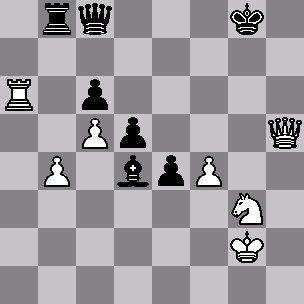
42...Qxa6.
Game drawn.
P.S. Alexander Khalifman managed to bring the game into a position that is little known for his opponent. Black did not get sufficient compensation for the sacrificed pawn. Then White started to err, and the game eventually ended in a draw, which can be considered a favorable outcome both both players.
Back to the Superfinal main page
